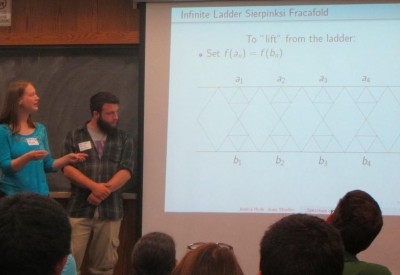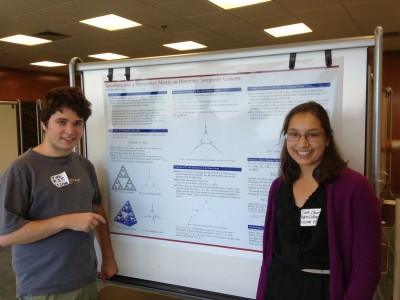Event
AMS Sectional Meeting @ Stony Brook
Alexander Teplyaev, Luke Rogers, Ulysses Andrews
We consider the wave equation on the unit interval with fractal measure, and use two numerical models to study wave speed and propagation distance. The first approach uses a Fourier series of eigenfunctions of the fractal Laplacian, while the second uses a Markov chain to model the transmission and reflection of classical waves on an approximation of the fractal. These models have complementary advantages and limitations, and we conjecture that they approximate the same fractal wave.
UConn Summer Research Symposium
UMass Summer Research Symposium
Geodesics and a Riemannian Metric on Harmonic Sierpinski Gaskets

Jessica Hyde, Jesse Moeller, and Luis Seda
One project investigated magnetic gauge fields on the Sierpinski Gasket. After numerical experimentation, using Mathematica and MatLab, this team determined that specific portions of the spectrum of the Laplacian are unaffected by a perturbating magnetic field given by a harmonic 1-form of finite topological type and continued on to prove that this. In a specific case they also gave a description of the spectrum via a covering space and symmetry argument. They presented a poster and a talk on this work at the REU mini-conference at the University of Massachusetts, Amherst and gave a talk at the Young Mathematician’s Conference at Ohio State University.
Spectrum of the Magnetic Laplacian

This team worked on the existence of measurable Riemannian structures in the sense of Kigami on higher dimensional Sierpinski-type gaskets. Some time ago, Kusuoka proved existence of a measure, metric (in the Riemannian sense) and gradient operator on a class of fractals that includes these gaskets, such that these objects bear the same relation to the Dirichlet form as do the Riemannian volume, metric and gradient on Euclidean space. Kigami later completed this picture in the case of the usual 3-vertex Sierpinski gasket by constructing a geodesic length that is the analogue of that occuring in the Riemannian case and proving Gaussian heat kernel estimates, and Kajino has subsequently proved very re ned estimates for the heat kernel in this setting. It was believed that although Kigami’s approach relied on certain 2-dimensional techniques the results would also be valid on Sierpinski-type gaskets with more vertices, and that is what our research team have proved. They presented a poster on this work at the REU mini-conference at the University of Massachusetts, Amherst, and are writing the results up for publication.
Geodesics and a Riemannian Metric on Harmonic Sierpinski Gaskets